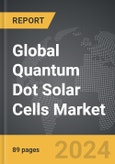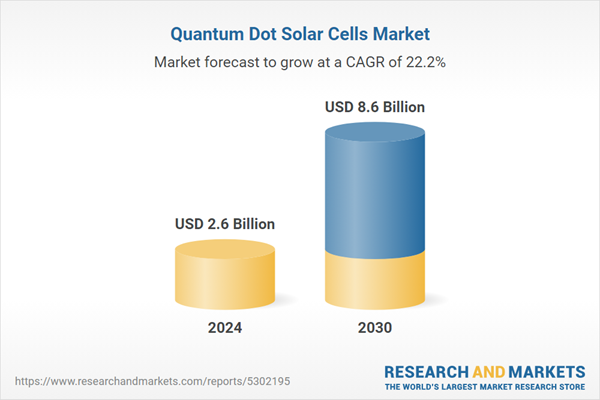Global Quantum Dot Solar Cells Market - Key Trends and Drivers Summarized
What Are Quantum Dot Solar Cells and How Do They Differ from Traditional Photovoltaics?
Quantum Dot Solar Cells (QDSCs) are an emerging class of photovoltaic technology that leverage the unique optical and electronic properties of quantum dots to convert sunlight into electricity with greater efficiency and flexibility than traditional silicon-based solar cells. Quantum dots are semiconductor nanocrystals that, due to their nanoscale size, exhibit quantum mechanical properties, including the ability to manipulate their bandgap by varying the size and composition of the nanocrystals. This tunability allows QDSCs to absorb specific wavelengths of light more efficiently, enabling them to harness a broader spectrum of solar radiation, from ultraviolet (UV) to near-infrared (NIR) wavelengths. Traditional silicon solar cells, by contrast, are limited to a fixed bandgap, which restricts their absorption to a narrower range of the solar spectrum, resulting in energy loss and lower conversion efficiencies. The unique feature of QDSCs is their ability to utilize “hot carriers” (high-energy electrons generated by the absorption of sunlight) more effectively, which can potentially surpass the theoretical efficiency limit of conventional cells, known as the Shockley-Queisser limit. Moreover, quantum dots can be incorporated into a variety of device architectures - such as tandem cells, hybrid systems, and even semi-transparent films - allowing for innovative applications that go beyond standard flat-panel installations. As a result, QDSCs are poised to significantly enhance the performance and versatility of solar technologies, making them an attractive option for both traditional power generation and emerging applications like building-integrated photovoltaics (BIPV) and wearable solar devices.What Are the Current Trends and Technological Innovations in Quantum Dot Solar Cells?
The field of Quantum Dot Solar Cells is witnessing rapid advancements, driven by ongoing research into quantum dot synthesis, surface passivation, and device architecture optimization. One of the most promising trends is the development of multi-junction and tandem QDSCs, where different types of quantum dots are layered to capture a wider range of the solar spectrum, thereby boosting overall efficiency. This multi-junction approach allows each layer to absorb light at different wavelengths, minimizing energy losses and enabling power conversion efficiencies that rival or even exceed those of traditional silicon cells. Researchers are also exploring the use of lead-free quantum dots, such as perovskite quantum dots, to address environmental and toxicity concerns associated with conventional lead- or cadmium-based quantum dots. These new materials not only offer comparable performance but also promise better stability and environmental safety, making them suitable for large-scale deployment. Additionally, hybrid solar cells that combine quantum dots with organic or perovskite materials are emerging as a key area of innovation, as they offer improved charge transport and light-harvesting capabilities. This hybridization can enhance the stability and scalability of QDSCs, making them more viable for commercial applications. Another notable trend is the exploration of semi-transparent and flexible QDSCs, which are designed for integration into windows, facades, and even wearable electronics. These novel form factors open up new possibilities for integrating solar power into everyday materials and surfaces, transforming the way in which solar energy is harvested and utilized. The pursuit of scalable manufacturing techniques, such as roll-to-roll processing and inkjet printing, is also a major focus, as these methods could significantly reduce production costs and accelerate the commercialization of QDSCs for diverse applications.How Are Quantum Dot Solar Cells Impacting the Competitive Landscape of the Solar Industry?
Quantum Dot Solar Cells are beginning to disrupt the competitive dynamics of the solar industry by offering a unique combination of high efficiency, flexibility, and potential for low-cost production that is difficult for conventional silicon technologies to match. Leading solar technology companies and research institutions, such as First Solar, Quantum Materials Corp, and the University of Toronto, are heavily investing in the development and commercialization of QDSCs to tap into new market opportunities. This push is creating a new competitive segment within the photovoltaic industry, where QDSCs are being positioned as the next-generation solution for applications that demand more than just standard panel-based installations. In the realm of building-integrated photovoltaics (BIPV), for example, the semi-transparent nature and customizable form factors of QDSCs make them an ideal candidate for solar windows and energy-generating facades. This application is particularly appealing in urban environments, where traditional rooftop installations are often limited by space constraints. Additionally, the lightweight and flexible nature of QDSCs is driving interest in portable and wearable solar devices, such as solar-powered fabrics and backpacks, which could bring energy generation capabilities to new, unconventional surfaces and mobile applications. The automotive industry is also exploring QDSCs for use in integrating solar panels into vehicle surfaces to power onboard electronics or even extend the driving range of electric vehicles (EVs). This broad application potential is prompting established photovoltaic manufacturers to rethink their strategies and expand their product lines to include QDSC-based solutions. Meanwhile, new entrants and startups specializing in nanotechnology and advanced materials are positioning themselves as innovation leaders in this space, pushing the boundaries of what quantum dot solar technologies can achieve.What Are the Key Growth Drivers in the Quantum Dot Solar Cells Market?
The growth in the Quantum Dot Solar Cell market is driven by several key factors, including technological advancements, rising demand for high-efficiency photovoltaics, and the push for more versatile solar solutions. One of the primary growth drivers is the increasing focus on improving power conversion efficiency (PCE), which is a critical metric for determining the economic viability of any solar technology. Recent advancements in quantum dot synthesis and surface engineering have led to significant improvements in the stability and efficiency of QDSCs, making them more competitive with established technologies. Another major driver is the growing emphasis on sustainability and the need for environmentally friendly solar technologies. The development of lead-free and cadmium-free quantum dots, as well as the use of non-toxic, earth-abundant materials, has positioned QDSCs as a greener alternative to traditional solar cells, aligning with the global trend towards sustainable energy solutions. Additionally, the increasing demand for flexible and lightweight solar modules is creating new opportunities for QDSCs, as their ability to be fabricated on a variety of substrates - including plastics, glass, and textiles - opens up a wide range of applications that are not feasible with conventional silicon panels. This versatility is particularly relevant for portable and wearable solar devices, as well as for integration into smart windows and building facades. The expanding adoption of Quantum Dot Solar Cells in niche markets such as aerospace and defense, where the need for lightweight, high-efficiency power sources is critical, is further driving demand. Moreover, the pursuit of cost-effective production methods, such as solution-based processing and printing techniques, is expected to lower manufacturing costs and facilitate large-scale commercialization. With continued research, development, and investment, Quantum Dot Solar Cells are poised to experience robust growth, driven by their potential to redefine the efficiency and application scope of photovoltaic technology, ultimately supporting the global transition to cleaner and more versatile solar energy solutions.Report Scope
The report analyzes the Quantum Dot Solar Cells market, presented in terms of market value (USD Thousand). The analysis covers the key segments and geographic regions outlined below.Segments
End-Use (Consumer, Commercial, Telecommunications, Healthcare, Defense, Other End-Uses).Geographic Regions/Countries
World; United States; Canada; Japan; China; Europe (France; Germany; Italy; United Kingdom; Spain; Russia; and Rest of Europe); Asia-Pacific (Australia; India; South Korea; and Rest of Asia-Pacific); Latin America (Argentina; Brazil; Mexico; and Rest of Latin America); Middle East (Iran; Israel; Saudi Arabia; United Arab Emirates; and Rest of Middle East); and Africa.Key Insights:
- Market Growth: Understand the significant growth trajectory of the Consumer End-Use segment, which is expected to reach $2.4 Billion by 2030 with a CAGR of a 20.1%. The Commercial End-Use segment is also set to grow at 23.8% CAGR over the analysis period.
- Regional Analysis: Gain insights into the U.S. market, valued at $720.2 Million in 2024, and China, forecasted to grow at an impressive 21.1% CAGR to reach $1.3 Billion by 2030. Discover growth trends in other key regions, including Japan, Canada, Germany, and the Asia-Pacific.
Report Features:
- Comprehensive Market Data: Independent analysis of annual sales and market forecasts in USD from 2024 to 2030.
- In-Depth Regional Analysis: Detailed insights into key markets, including the U.S., China, Japan, Canada, Europe, Asia-Pacific, Latin America, Middle East, and Africa.
- Company Profiles: Coverage of major players such as Avantama, Crystalplex Corporation, Nanoco Group, Nanosys, Navillum Nanotechnologies and more.
- Complimentary Updates: Receive free report updates for one year to keep you informed of the latest market developments.
Why You Should Buy This Report:
- Detailed Market Analysis: Access a thorough analysis of the Global Quantum Dot Solar Cells Market, covering all major geographic regions and market segments.
- Competitive Insights: Get an overview of the competitive landscape, including the market presence of major players across different geographies.
- Future Trends and Drivers: Understand the key trends and drivers shaping the future of the Global Quantum Dot Solar Cells Market.
- Actionable Insights: Benefit from actionable insights that can help you identify new revenue opportunities and make strategic business decisions.
Key Questions Answered:
- How is the Global Quantum Dot Solar Cells Market expected to evolve by 2030?
- What are the main drivers and restraints affecting the market?
- Which market segments will grow the most over the forecast period?
- How will market shares for different regions and segments change by 2030?
- Who are the leading players in the market, and what are their prospects?
Some of the 34 major companies featured in this Quantum Dot Solar Cells market report include:
- Avantama
- Crystalplex Corporation
- Nanoco Group
- Nanosys
- Navillum Nanotechnologies
- NN-Labs
- Ocean NanoTech
- Osram Licht
- Quantum Materials
- Samsung Electronics
Table of Contents
Companies Mentioned (Partial List)
A selection of companies mentioned in this report includes, but is not limited to:
- Avantama
- Crystalplex Corporation
- Nanoco Group
- Nanosys
- Navillum Nanotechnologies
- NN-Labs
- Ocean NanoTech
- Osram Licht
- Quantum Materials
- Samsung Electronics
Table Information
| Report Attribute | Details |
|---|---|
| No. of Pages | 89 |
| Published | April 2025 |
| Forecast Period | 2024 - 2030 |
| Estimated Market Value ( USD | $ 2.6 Billion |
| Forecasted Market Value ( USD | $ 8.6 Billion |
| Compound Annual Growth Rate | 22.2% |
| Regions Covered | Global |








